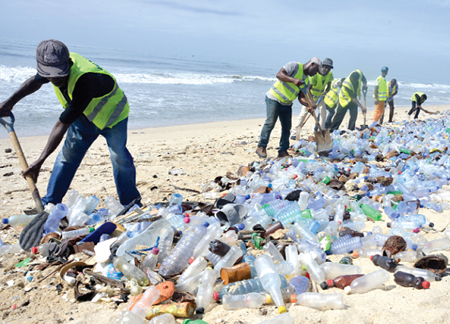Harm Within Plastic Pollution
- Home
- Harm Within Plastic Pollution

Harm Within Plastic Pollution
 As human population increases, so does our demand for goods and services, including our dependence on plastics.
As human population increases, so does our demand for goods and services, including our dependence on plastics.
Plastics have become necessary in our daily lives because their benefits are undeniable across sectors, from households, medicine, clothing, agriculture, transport etc.
As we use them to make life easy, we must think of the end of the life of plastics, as they also have expiry dates. Most plastics are made from fossils, that is, petroleum, and as Ghana is discovering large quantities of oil by the day, it means in a global and circular economy, plastics will reign for sometime, if not for a long time.
Single use
Single-use plastics, such as drinking straws, shopping bags, plastic drinking containers, plastic bottle caps, food packaging (Styrofoam, which contains styrene and benzene), among others, have been and are indiscriminately disposed of in an unfriendly and unsightly manner.
This affects our environment and obviously our health. All plastics contain toxic additives, which are used to make them flexible, flame-retardant, or meet other performance demands.
The cocktail of these toxic additives that go into making plastics enter the environment when plastics break down.
In the ocean, plastics quickly become microplastics, attracting toxic industrial chemical hitch-hikers. These are incorporated into the food chain and fishes eat them, creating one pathway for toxic microplastic accumulation in larger animals, like us, when we consume fish.
Only a fraction of all plastic waste has been recycled – nine per cent and moreover, there are no “good ways” to dispose of non-recyclable plastic waste.
Bio-degradable
Most plastics do not decompose or biodegrade except the bio-based ones. Plastics will remain in the environment, especially the soil and water bodies, for years and even at the end of their decomposition or biodegradation (if they are biodegradable) they are more dangerous.
When plastics enter the environment and oceans, they break into smaller minute particles called microplastics and or nanoplastics.
These microplastics enter the food chain and finally end up in the foods we eat. Our bodies do not become the resting places for them, but rather they get into the biochemical processes in the body by imitating the natural chemicals (hormones) produced.
Once in the body, these substances can lead to the malfunctioning of the target organs ending up in nervous systems, lungs and reproductive organs.
Humans are exposed to a large variety of toxic chemicals and microplastics through inhalation, ingestion, and direct skin contact, all along the plastic life cycle
Effects
Single use plastics choke drains, creating breeding sites for mosquitoes, they are left on dumpsites, where animals sometimes mistake them for food and get choke to death, they are burnt openly causing smoke containing hazardous substances like furan and dioxins, which are cancer causing agents.
If our current practices and attitudes towards the production, handling and disposal of plastics are not modified, then we are heading towards a non-achievement of the Sustainable Development Goals (SDGs) and the consequences would be more grave than we have today, leaving a heavy burden for the future generations.
Reduction
To reduce the menace of plastic waste is to reduce its production, use and to institute better disposal mechanisms, which must come from research and development to fill existing and future knowledge gaps.
Solutions must be built on transparency, participation and the right to remedy. Transparency is required to identify the nature and breadth of exposure to toxic material, as well as assess possible health and environmental impacts of technologies touted as “solutions,” such as incineration and plastic-to-fuel technologies to find alternatives which would be environmentally friendly.
At every stage of its lifecycle, plastic poses distinct risks to human health, arising from both exposure to plastic particles themselves and associated chemicals.
Addressing plastic pollution requires adapting and adopting legal frameworks to ensure access to information regarding the petrochemical substances in products and processes.
A broader stakeholder consultation is a must to find possible pathways to the formation of legislation in decision-making about plastic-related risks.
The writer is with Ecological Restorations,
E-mail: eaodjam@gmail.com
Source: Graphic Online
Classic Ghana
Classic Ghana brings you into a fun world of arts, entertainment, fashion, beauty, photography, culture and all things in between. Let’s explore these together!


